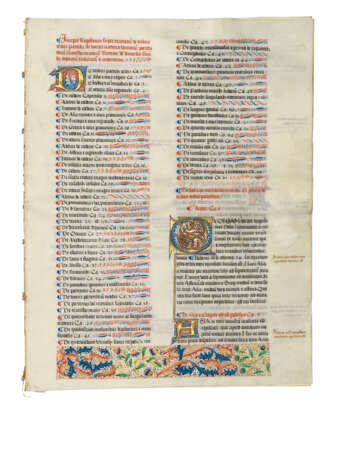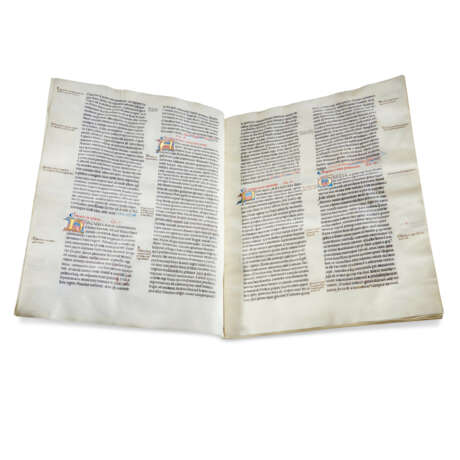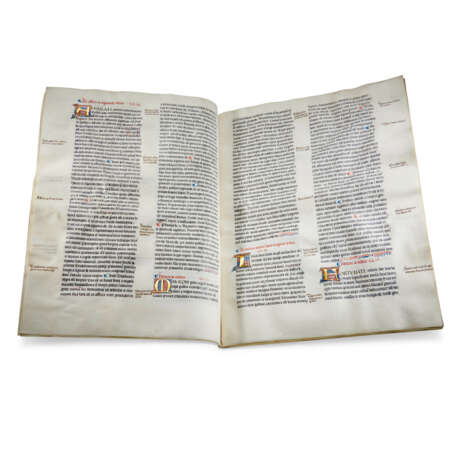ID 993363
Лот 41 | ?Johann Reger (1454 – d. after 1499)
Оценочная стоимость
£ 7 000 – 10 000
De locis ac mirabilibus mundi, illuminated manuscript on vellum [north-eastern France or Flanders, c.1470-1480]
A rare 15th-century manuscript copy of a geographical treatise on the places and marvels of the world, which first appeared in print in Johann Reger’s 1486 Ulm edition of Ptolemy’s Cosmographia. Once part of a grand, finely decorated compendium of medieval travel writing formerly in the collections of Sir Thomas Phillipps and Wilfrid Voynich: sister fragments are held at the University of Chicago and the Toledo Museum of Art, Ohio.
490 x 380mm. 21 leaves, textually complete, collation: 1-28, 35 (presumably of 8), three gatherings from a longer parent manuscript, quire markings for gatherings ‘B’ and ‘C’ survive, numbered ‘3’ in a later hand on f.1, two columns of 49 lines, ruled space: 410 x 125-30-125mm, marginal summaries in a contemporary hand, rubrics in red, initials alternating blue and red throughout, 61 three-line illuminated initials on red and blue grounds with white penwork decoration to open the chapters, one large (six-line) illuminated initial in red, blue and white on burnished gold grounds and a panel border of acanthus and flowers on hairline tendrils on f.1.
Provenance:
(1) Originally part of a compendium of geographical tracts written in the latter half of the 15th century; previously bound with: (i) a geographical treatise, 5ff., apparently an abridgement of a longer unidentified work (incipit: ‘Sequens descriptio orbis tam terrae quam maris’), now Ohio, Toledo Museum of Art, MS 35; and (ii) an abridged version of the Descriptio terrae sanctae of Burchard of Mount Sion (d.1285), 11ff., a description of travels in the Holy Land (incipit: ‘Descriptio seu declaration Terrae Sanctae’), now University of Chicago MS 707. The page dimensions, script and illumination are consistent across all three fragments; the style of the script and the decoration points to north-eastern France or Flanders as the place of production. These three tracts later appeared among the collections of:
(2) Guglielmo Libri (1803-1869), celebrated polymath, bibliographer, and thief: his sale at Sotheby’s, Catalogue of the Extraordinary Collection of Splendid Manuscripts [...] formed by Guglielmo Libri, 29 March 1859, lot 407 to –
(3) Sir Thomas Phillipps (1792-1872), English antiquary and book collector who amassed the largest collection of medieval manuscript material in the 19th century; sold at the Phillipps sale at Sotheby’s, 24 April 1911, lot 457, to:
(4) ‘Edwards’, probably the London-based bookseller Francis Edwards, who appears to have disbound the three tracts: the Descriptio terrae sanctae was acquired by the Rev. Frank W. Gunsaulus (1856-1921), who gave it to the University of Chicago in 1915, while our manuscript and the five-leaf Descriptio orbis came into the possession of:
(5) Wilfrid Voynich (1865-1930), Polish revolutionary, antiquarian and bibliophile remembered as the eponym of the celebrated Voynich manuscript at the Beinecke. Our manuscript was purchased in 1915 for the Art Institute of Chicago by Mrs Frank G. Logan following Voynich’s exhibition at the Art Institute, 7 October – 3 November 1915 (see ‘The Voynich Collection’, in Bulletin of the Art Institute of Chicago, vol IX, 1915, pp. 97-100, where this manuscript is described as follows: ‘a Description of the World, anonymous work, written and illuminated in Paris in the second half of the fourteen century, very likely for the Sorbonne). The Descriptio orbis is now held in the Toledo Museum of Art, Ohio.
Content:
De locis ac mirabilibus mundi, in 61 chapters, opening ‘Quoniam ut ait Agustinus’, preceded by an index (‘Incipit Registrum super tractatu[m] de tribus orbis partib[us]’) ff.1-20v; ruled blank f.21.
In Johann Reger's 1486 edition, Ptolemy's Geographia is followed for the first time by the treatise De locis ac mirabilibus mundi, an encyclopaedic description of the habitable world – the continents, islands, towns, rivers, mountains and seas; the monstrous human races and the Earth’s marvels, from Mount Etna to the exotic animals of the East – and of the heavens. The success of the Ulm Geographia was such that many who had already purchased Holl’s 1482 edition updated their copies with the accessory texts of 1486; some purchased pirated reprints from competitors including the Nuremberg printer Anton Koberger. The De locis treatise is anonymous: the cartographer Nicolaus Germanus (c.1420-c.1490) was once thought to have been its author, but research has shown that the text was only added to Nicolaus’ manuscript of the Geographia after Reger produced his 1486 edition (see M. Hoogvliet. ‘The Medieval Texts of the 1486 Ptolemy Edition by Johann Reger of Ulm’, Imago Mundi, vol. 54, 2002, pp.7–18). The text is based on earlier medieval sources, including Vincent of Beauvais's Speculum naturale, Isidore of Seville’s Etymologiae, and Solinus's Collectanea rerum memorabilium. The author may well have been Johann Reger himself, Hoogvliet suggests, desiring to supplement the mathematical geography of Ptolemy with a textual mappa mundi drawn from medieval sources. The inclusion of De locis in 15th-century editions of the Cosmographia reflects the continued relevance of earlier works of descriptive geography for the contemporary reader in the immediate aftermath of the so-called ‘Ptolemaic Revolution’.
The script and decoration of our manuscript attest to a dating in the latter half of the 15th century – whether it could predate the 1486 Ulm edition of the Geographia is unclear. The index on f.1 does not appear in Reger’s edition, but the text otherwise appears to be the same. Either way, medieval manuscript exemplars of De locis are rare: none have appeared before at auction (according to RBH) and Schoenberg Database records only this copy. The text does appear in a 15th-century manuscript at the Lilly Library (LMC 2450), but further comparables are scarce.
Special notice
This lot has been imported from outside of the UK for sale and placed under the Temporary Admission regime. Import VAT is payable at 5% on the hammer price. VAT at 20% will be added to the buyer’s premium but will not be shown separately on our invoice.
| Автор: | Иоганн Регер (1454 - 1499) |
|---|---|
| Место происхождения: | Бельгия, Западная Европа, Франция, Европа |
| Категория аукционного дома: | Манускрипты Средневековья и Ренессанса |
| Автор: | Иоганн Регер (1454 - 1499) |
|---|---|
| Место происхождения: | Бельгия, Западная Европа, Франция, Европа |
| Категория аукционного дома: | Манускрипты Средневековья и Ренессанса |
| Адрес торгов |
CHRISTIE'S 8 King Street, St. James's SW1Y 6QT London Великобритания | |
|---|---|---|
| Предосмотр |
| |
| Телефон | +44 (0)20 7839 9060 | |
| Комиссия | see on Website | |
| Условия использования | Условия использования |






